AI content detection has become a crucial aspect of modern digital communication as artificial intelligence continues to advance at an unprecedented rate. Content creators, marketers, entrepreneurs, and website proprietors must be aware of the instruments and strategies available to recognize AI-generated text as it becomes more commonplace online.
This blog post will investigate the importance of detecting AI-generated content and discuss whether Google can effectively identify these texts. Furthermore, we’ll explore methods for detecting AI-written text generated by models like GPT-3 or ChatGPT.
We will also list some of the best AI content detectors today while shedding light on their limitations. By better understanding these aspects of AI content detection, you can make informed decisions when creating and managing your digital assets.

More Resources :
Importance of Detecting Ai Content
AI is quickly becoming more commonplace as technology advances. Furthermore, users worldwide are adopting the technology with curiosity and trepidation.
AI tools, such as ChatGPT, make it simple for anyone to enter a query for a specific task or inquiry and generate a completed result that may be satisfactory to them. Unlike a search engine, which returns a list of results, artificial intelligence engines such as ChatGPT can respond to your prompt with answers or completed tasks.
Users can ask simple questions to artificial intelligence tools or instruct them to complete a task, such as writing a blog post. As a result, the advancement of AI tools has proven to be a challenge for businesses.
Copywriters, contractors, and freelance writers may experiment with using an AI tool to write an article for a company’s blog. More than 15% of writers use an AI tool to improve their writing.
An AI-generated article could be incorrect, similar to everything else that has already been posted, or even plagiarized. Businesses want to always publish relevant, optimized, up-to-date content with a distinct point of view.
If the company’s freelancers use AI software to generate their posts, the brand may suffer, and company resources may be well-spent.
However, there are advantages to incorporating AI into your business. In some cases, using AI may improve the output of an in-house content production team.
This will free up resources for your content and digital marketing teams to focus on other aspects of your SEO strategy or business. Writers who use AI can draught more blog posts faster than those who do not.
About 38% of non-AI writers believe it takes them 3-4 hours to write a post, whereas 38% of AI writers believe it takes them only 2-3 hours.
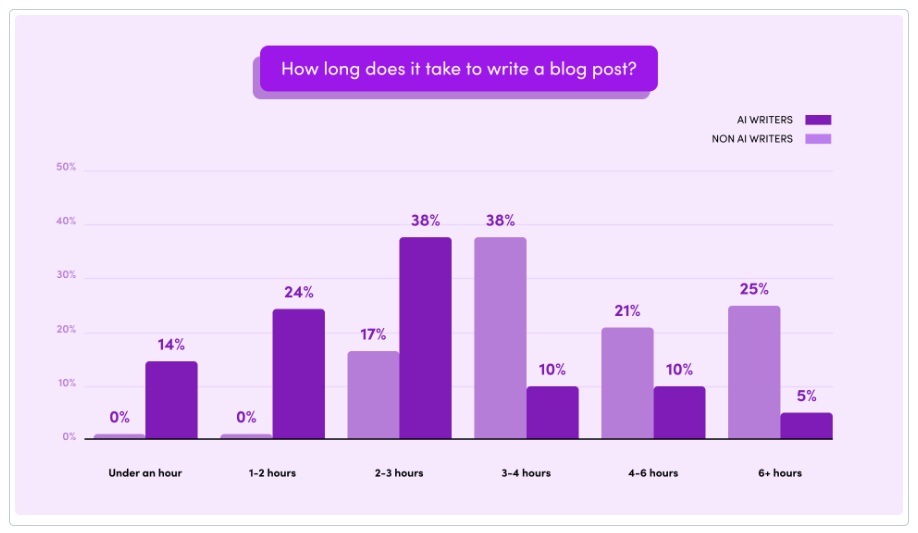
Are There Penalties for Detecting AI On Your Website?
Content marketers have attempted to “game the system” for years by determining what performs best on Google’s algorithm.
When serving the most accurate content for users ‘ queries, Google considers several positive and negative factors. All of these elements have an impact on a site’s SEO rankings.
Citation listings, domain links, mobile-first layouts, accessibility, security, keywords, meta tags, length, readability, and other factors are among them.
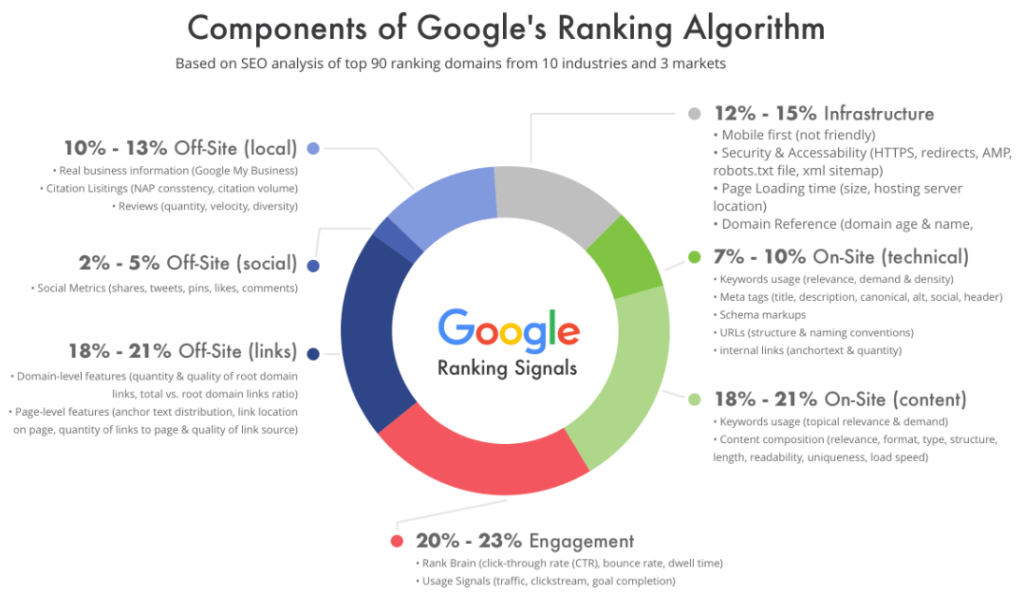
Google recently issued guidance on its approach to AI-generated content.
The company “focuses on the content’s quality rather than how the content is produced.” Google cited its ranking and helpful content systems as two distinct barriers to spammy AI-generated content.
The ranking system is in place to discover and present high-quality, original content to Google users. Instead of surfacing optimized content, the recently introduced helpful content system identifies web pages and articles that answer users’ questions.
While creating content, writers should keep both of these systems in mind. Businesses experimenting with incorporating AI-generated content into their content strategy must do the same.
More Resources :
Best AI Content Detectors
With the rise of AI-generated content such as GPT3 or ChatGPT, it’s become essential to detect artificial intelligence-generated text from human-written text. Fortunately, there are tools available that can help us do this with high accuracy rates.
#1. Writer
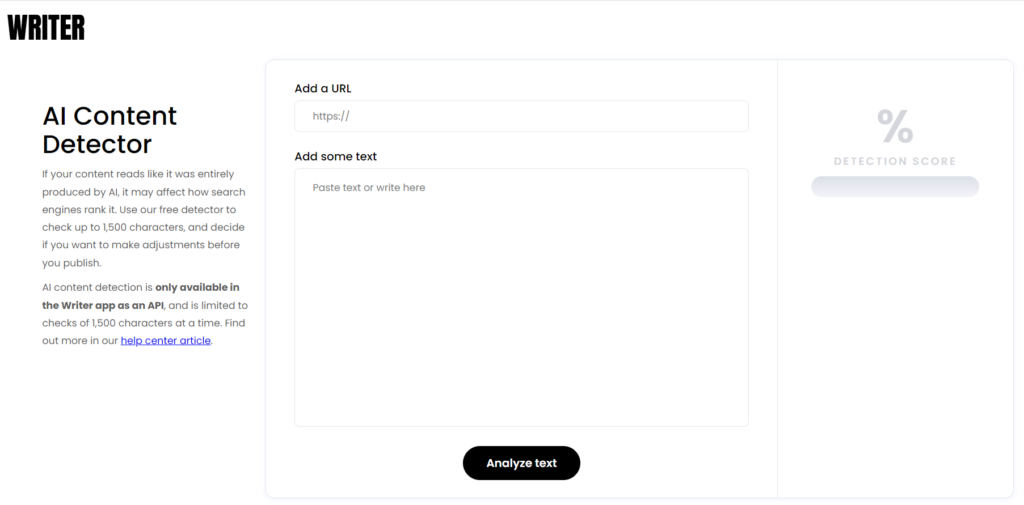
The writer is a powerful platform that helps copywriters create and refine their writing. Its AI content detection tool can detect any text generated by artificial intelligence with just a few clicks.
This feature makes it easier for writers to ensure their work’s originality and ensure they are not plagiarizing someone else’s work.
The platform has an easy-to-use interface that allows users to paste in or upload a URL of the article they wish to analyze.
After clicking “Analyze Text,” the Writer will provide an exact percentage of AI-generated content detected within the article.
The accuracy rate is impressive as Writer uses advanced algorithms and machine learning technology to identify potential plagiarism issues quickly and accurately.
This AI content detection tool also provides valuable feedback on how well-written the article is, such as tone recommendations, grammar suggestions, sentence structure analysis, readability scores, and more – all designed to help writers improve their craftsmanship without having to go through each line of text themselves manually.
In addition, this feature can be used in tandem with other features like spell checkers or auto correctors for further refinement before publishing articles online or submitting them for publication elsewhere.
Overall, Writer’s AI content detection tool offers invaluable assistance when it comes to detecting potential plagiarism issues in articles quickly and accurately while providing helpful feedback on improving one’s writing skills at the same time – making it an essential part of any writer’s arsenal who wants to stay ahead of the game!
#2. Copyleaks
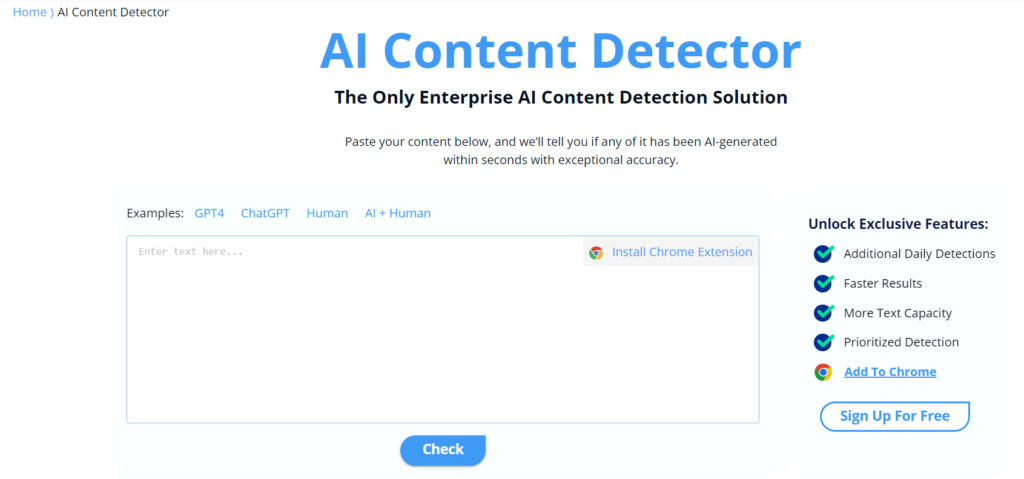
Copyleaks is an AI-powered content detector that helps protect businesses from copyright infringement.
With its Chrome Extension, you can also detect it on browsing pages.
This tool is especially useful for ensuring their content isn’t plagiarized or copied from other sources. The interface is easy to use and intuitive, so even if you need to be tech-savvy, you’ll know exactly what to do when landing on the page.
Plus, its AI Grader feature is great for assessing school assignments that may have been generated by artificial intelligence (AI).
In addition to detecting plagiarism, Copyleaks has other services like copyright protection and automated document comparison,, making it a great all-in-one solution for anyone looking to protect their intellectual property rights online.
Furthermore, they offer real-time monitoring and automatic alerts in case someone tries to copy your work without permission – giving users peace of mind knowing their hard work won’t be stolen without them knowing about it first!
#3. Content at Scale
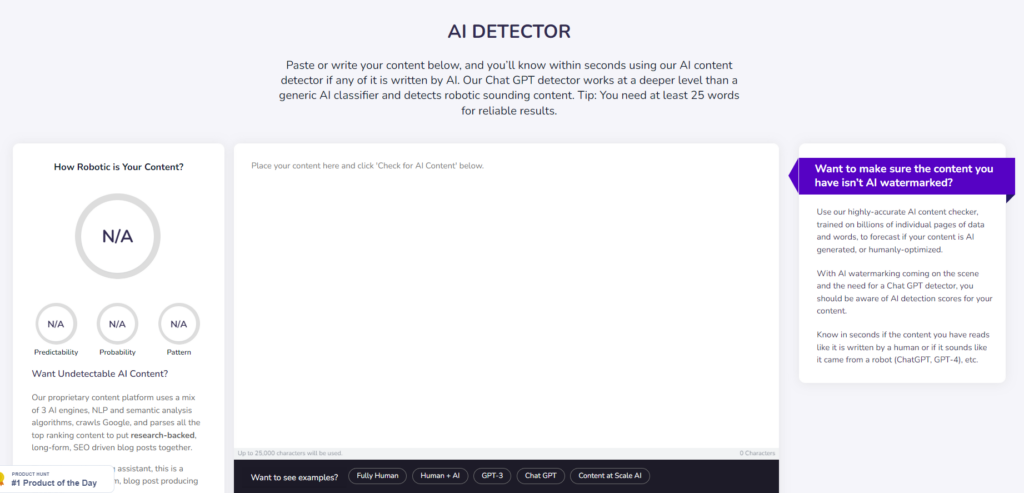
Content at Scale is an AI content detector and writing platform that provides users with a unique way to detect plagiarism.
The company’s AI Detector can provide a verdict within seconds after submitting the content, giving it an edge over other detection tools.
Content at Scale stands out because of its “human content score,” which combines predictability, probability, and pattern scores to give insight into why the tool thinks AI generated the content.
This human aspect of Content at Scale gives it an extra layer of accuracy when detecting plagiarized or machine-generated text.
It also helps users understand what led to the overall rating so they can make better decisions about their work in the future.
In addition, this platform offers features such as automated grammar checks and keyword optimization for SEO purposes, which help optimize user-generated texts for maximum impact on search engine rankings.
Overall, Content at Scale has become one of the most popular platforms for detecting plagiarism due to its advanced features and reliable results.
#4. Originality.Ai
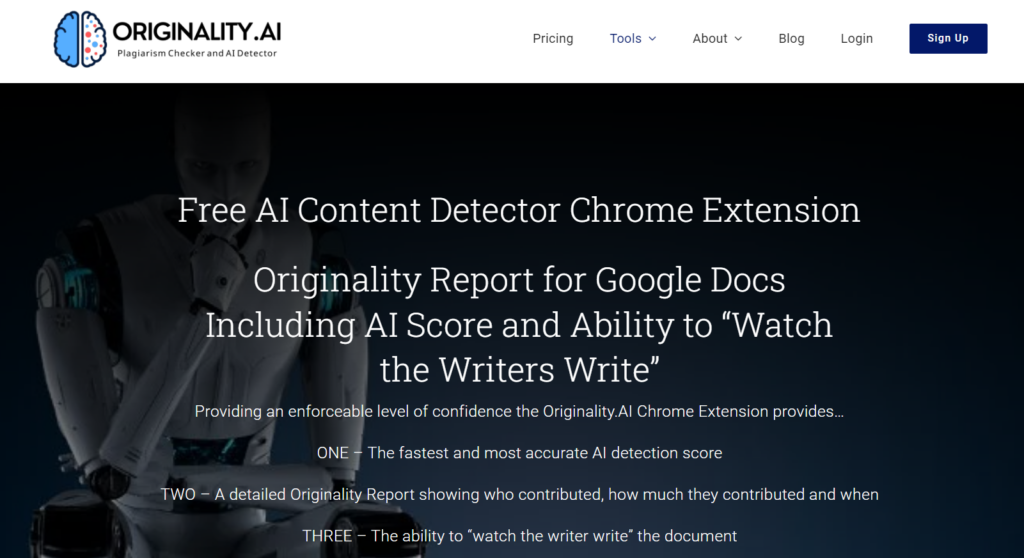
Originality.AI is a Google Chrome extension that helps to detect AI-generated content in real-time. It’s designed to help users avoid plagiarism and create original, unique content.
The extension works by analyzing the text on a page or document and comparing it against an extensive database of other texts online. If any similarities are found, Originality.AI will alert the user so they can take action accordingly.
The main benefit of using Originality.AI is its speed; you don’t have to copy and paste your work into another program or add URLs for evaluation – it’s all done automatically within seconds!
This makes it ideal for busy professionals who need quick results when checking their work or someone else’s writing before publishing it online.
Additionally, the free version offers basic features such as scanning documents up to 500 words long with no extra cost – making this tool accessible even if you’re on a tight budget!
However, some users have reported feeling misled by hidden fees associated with the product after signing up for the free version – something that could be improved upon in future updates of Originality. AI.
Despite this drawback, many people still find value in using this tool due to its convenience and accuracy when detecting AI-generated content quickly and easily – allowing them “to sleep easy at night,” knowing their work won’t be flagged as plagiarized later down the line!
#5. GPT Zero
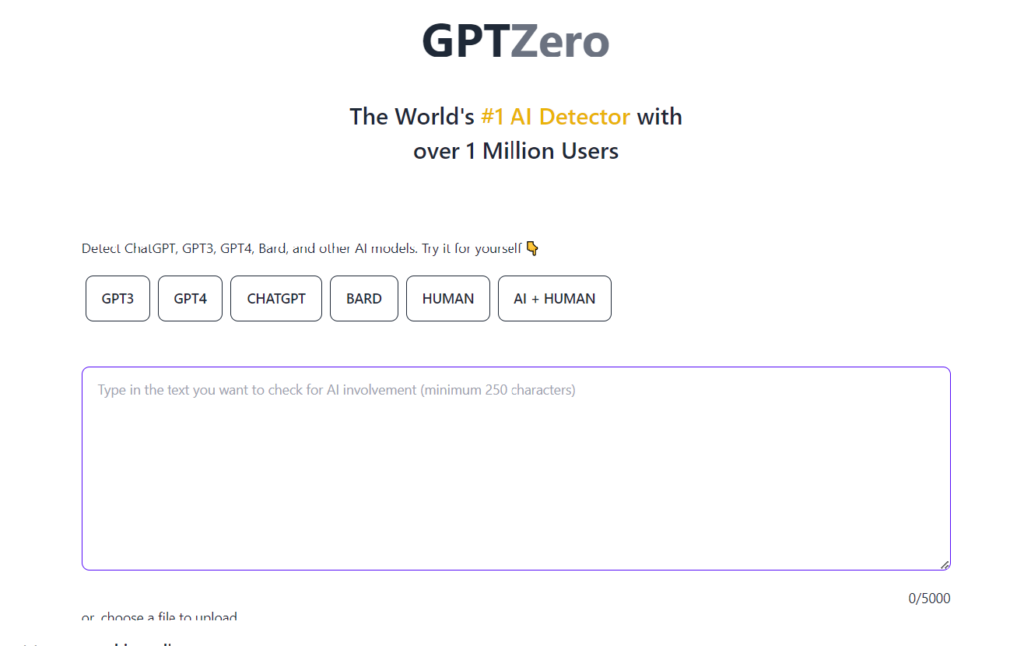
GPT Zero is an AI content detector that can quickly and easily assess whether or not your content has been generated by artificial intelligence.
It’s a great tool for businesses to use to ensure their content remains unique and original and for educators who need to check if students have plagiarized.
The interface of GPT Zero is incredibly user-friendly; it looks similar to Google’s homepage, with just a simple call-to-action button that says “Try it Out,” along with a box where you can paste your article into the system.
Once you’ve done this, GPT Zero will be able to detect any AI-generated material within seconds.
GPT Zero is appealing because of its speed and accuracy; it’s one of the most reliable tools for detecting AI-generated text.
Furthermore, unlike other platforms which offer more sophisticated features such as grammar checking or keyword analysis, GPT Zero keeps things nice and simple – all you need do is copy-paste your article into the box on the screen and let the system do its job!
In short, if you’re looking for an easy way to ensure your business’ content isn’t being created by robots, look no further than GPT Zero – it’ll save you time and money in the long run!
#6. Corrector App
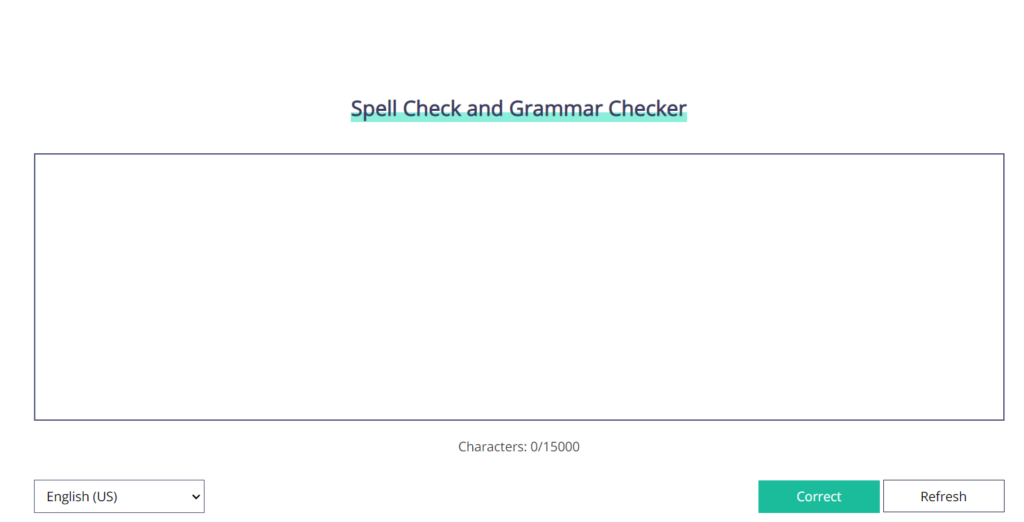
Writers use the Corrector App to identify grammatical errors in their articles. The Corrector App now includes a new AI content detection tool to supplement its other capabilities.
This lesser-known AI content detection tool is available to all users for free. A minimum of 300 words is required by the tool. You might use this app for a quick check, but better options are available.
The user experience of the Corrector App could be better on the market. The ads on the page are annoying, and the overall experience is limited.
Can Human-Written Text Be Classified as Ai-Generated Text?
The quick answer is yes!
For example, a new Google Search algorithm update may mistakenly mark some innocent sites as AI-generated, even though humans created them.
The issue with this type of classification is that it relies on machine learning models and natural language processing (NLP) technology to detect patterns in the text and determine whether or not an AI system created it.
However, these technologies are still relatively new and have limited capabilities in accurately detecting human-written content from AI-generated material.
In addition, there are certain characteristics of human writing that machines cannot yet recognize, such as idioms and colloquialisms, subtle nuances in grammar, and creative turns of phrases that often make up the essence of good writing.
As a result, machines may struggle to distinguish between what has been written by a person versus what has been produced by an artificial intelligence system – leading them to incorrectly classify some pieces of human-created work as being “AI generated” instead.
Does Google Detect and Punish Ai Content?
Google and other search engines constantly evolve algorithms to understand the web’s content better. AI-generated content is no exception, but does that mean it will be punished?
The answer is a resounding “no.” Google doesn’t care whether a human or an AI writes your content; they want quality.
If the user finds what they’re looking for in your article, you’ve done your job right. If you don’t try to manipulate search engine rankings with keyword stuffing or link exchanges, you won’t get penalized for using AI-generated content.
That said, there are still some risks associated with using AI-generated content. For example, if everyone starts creating thousands of pages of low-quality articles at once, Google might start punishing them all – even those created by humans!
This could lead to a general uneasiness amongst folks in the SEO community who worry about being lumped together with black hat tactics like this one.
To avoid getting caught up in this mess, use AI writing tools responsibly and focus on delivering value for readers instead of trying to game the system.
Quality should always come first when producing great online content – regardless of whether an algorithm wrote it!
Limitations of AI Detection Tools
AI content detectors are powerful and effective, yet they have some restrictions that should be considered when utilizing them.
Despite the many benefits of AI detection tools, there are still some limitations that need to be taken into account. It is essential to consider the possible repercussions of these restrictions and decide if they outbalance the potential gains before deciding. Moving on, let us look at our conclusion regarding AI content detection.
FAQs About Ai Content Detection
Conclusion
With AI content detectors like On-Page.ai, Writer.com, GLTR, and Content At Scale, businesses can quickly detect potential issues before publishing the final product online or elsewhere. These tools are invaluable in helping businesses ensure they are not using artificially generated content without proper authorization – protecting them from potential legal repercussions.
At the same time, it’s important to remember that these AI detection tools also have limitations. For this reason, businesses should always double-check with a human editor before publishing anything produced by an AI system just to be safe – particularly if sensitive information is involved.
Overall, AI content detectors are incredibly useful for saving time and money while ensuring quality control over published material – making them essential for any business hoping to stay ahead of the curve regarding digital marketing strategies and tactics.
By leveraging these powerful tools alongside human editors whenever necessary, companies can rest assured knowing that their digital presence will remain secure from potential legal ramifications due to unauthorized use of artificial intelligence technology in their products or services.
With a careful combination of AI detection and manual review, businesses can create high-quality content quickly and efficiently without having to worry about potential issues down the line.